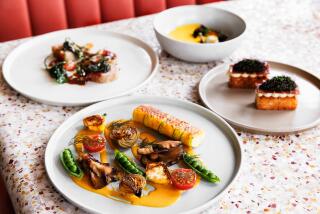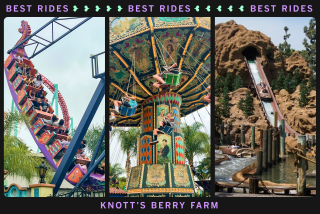Trolling San Diego by Trolley
No vehicle deserves a break more than my little red pickup truck. In 15 years, it has ferried me safely over 271,000 miles of the planet. So it was pure joy to check the truck into the parking garage at the Bristol San Diego hotel for a weekend last month. This not only gave it a rest, but also left me and my companion, Marc, free to explore the city by trolley, using minimal shoe leather.
The San Diego Trolley first carried passengers in 1981. Now more than 83,000 people a day ride it to work, school and home--and sometimes to an art museum, historic sites and a nature center, as we planned to do.
We stashed our bags in our sixth-floor room. From a window, we saw red trolley cars rolling. But it was Friday night, the end of a busy week, and all we wanted was a good night’s dreams.
The next morning, we found the Civic Center station at C Street and 3Third Avenue, about two blocks from the hotel. Instructions on a vending machine told us how to buy tickets. Round-trip fares range from $2 to $5, but we snapped up two-day, unlimited-ride Day Tripper passes for $8 each.
With two lines running trolleys every 15 minutes, the system is easy to navigate; the Blue Line goes from Mission San Diego de Alcalá to the Mexico border, and the Orange Line from downtown to Santee. Our weekend would be Blue Line all the way.
First stop: Bayfront/E Street. Destination: the Chula Vista Nature Center. The center runs a free shuttle from the station to the weathered wood building rising from Sweetwater Marsh National Wildlife Refuge.
The center stands on Gunpowder Point, once home to the largest kelp processing plant in Southern California. Kelp, shipped into San Diego Bay by barge, supplied two key ingredients for making explosive powder during World War I, the factory’s heyday.
NLittleothing remains of the vast network of bridges, pipes and tanks. The area’s animals and plants are slowly reclaiming their old ground, as the center shows.
Just inside the door, a purple aquarium filled with pulsating parachutes--moon jellies jellyfish--welcomes visitors with a hint of visual treats to come.
Some exhibits bring visitors close to the action. “Look at this!” Marc said, nearly bumping his head in a short, cave-like hole beneath a fish tank. The view up revealed the underside of a bat ray, from a snail’s perspective.
Visitors can get even closer outdoors. A bird observation platform provides a panorama of the marsh--snowy egrets, hummingbirds, waving grasses--all the way to the bay. The marsh is home to about 215 bird species. Exhibits resembling batting cages house burrowing owls and dappled brown marsh birds called clapper rails.
The best exam room is the petting pool, a cement pond of leopard sharks and bat rays. Sharks the size of cocker spaniels and rays about as big as house cats cruise through the water as eager fingers reach down to touch them. Here’s a firsthand report: Rays feel slick; sharks, like sandpaper.
The shuttle delivered us back to the trolley station for a 15-minute ride to the San Ysidro station at East Beyer and East San Ysidro boulevards, steps from the U.S-Mexico border.
Tijuana has acquired kiosks with street maps since our last visit, making it much easier to navigate. It has lost none of its mixture of tacky doodads for sale, prescription medicine dispensaries, dozens of dentists and sincere glimpses of heritage.
Does anyone really buy these glass flowers, ceramic monkeys on miniature surfboards, lucha libre-style wrestling masks and capes, black-velvet paintings of ’85 Buick Regals? We wound our way among the vendors and crossed over the Tijuana River to a street that seems made for American walkers and gawkers, Avenida Revolución.
Carlos Santana’s “Supernatural” blasted from storefronts. Small boys, their fingers dancing over accordion keys, shouted out ballads. Sad-eyed girls sold chewing gum for a quarter. And everywhere waiters fished for passersby.
We succumbed, following one of the fishermen upstairs to a restaurant, Señor Maguey. From our table on the balcony, we watched people schooling up and down the sidewalks.
My sampler plate--taquito, quesadilla, tostada and chimichanga--was unremarkable, but Marc’s “pollo Mex bowl” was to die for. An oversize lava bowl held a chicken stew with mild red chile sauce. The bowl was garnished with sliced avocado, two droopy rectangles of soft cheese, several slices of cactus, a whole green onion and a radish rose, with fresh, hot tortillas on the side.
We waddled back across the bridge to Viva Tijuana Plaza. While Marc bargained for a blanket, I checked out drummers and dancers in the middle of the square . The dancers’ costumes glittered in the golden afternoon, and the pheasant feathers in their headdresses fluttered. The dance steps, they said, were Aztec.
Marc returned without a blanket. Deep down, he never wants to buy one. The quest for a blanket is his reason to cross the border, and he doesn’t want to give it up.
The border crossing had become busier as the afternoon grew old. Guards herded us into single-file lines for U.S. Customs, which allows 1 liter of alcohol and $400 worth of goods to be brought back. I declared my chewing gum, and soon we were on the trolley, bound for a nap in the hotel.
Our dinner destination was San Diego’s Little Italy, a neighborhood two blocks east and a block north of the County Center/Little Italy station. A sign arching over India Street announces the community, which was host to an invitational stickball tournament the weekend we visited. We didn’t think we’d get a table; hungry people queued up at all the restaurants except one.
Inside that one, Zagarella, the hostess warned us that the kitchen was running behind because of a large party in the back room. But we could have a table, one of only seven in the cozy front dining room, which is embellished with murals of Mediterranean towns and clouds painted on the sky-blue ceiling.
If the kitchen was behind, we couldn’t tell. Within 20 minutes, the cheerful server brought our appetizer, pepperoni arrostiti, a 12-inch plate smothered in olive-oil-dressed roasted peppers, tart capers and a few salty anchovy fillets. Marc dug into his perfectly done salmon, while my pollo al limone con pinoli, a lightly breaded chicken breast in lemony sauce with pine nuts and an occasional golden raisin, transported me to food heaven.
For dessert, the tiramisu looked tempting until I thought of how it would look on my hips. So we sought a thinner alternative: a cup of coffee at any little place in Old Town San Diego State Historic Park. We took the trolley north three stops to the Old Town Transit Center, only to find all the little places closed.
As we walked past Seeley Stable, we heard pop-pop-BOOM behind us. Beyond the plaza’s tall trees sparkled fireworks, the show that explodes about 9:45 to 10 p.m. every day at Sea World. Alone by the stable, we watched chrysanthemums, chandeliers and heart-shaped rings glimmer and fade. It was time to go.
The Bristol describes its 102 guest rooms as colorful, and they are. Ours ($99 a night plus tax, energy fee and $12 for parking) was painted deep gold, except for a white wall at the head of the bed that set off a purple Matisse print. The yellow-and-orange awning-striped comforter, coir-print carpet and tan-and-black striped draperies gave the room a warm, outdoorsy feeling.
We snuggled into the hotel’s thick terry bathrobes and snapped on the tTVelevision,, which offers WebTV and video games. No WebTV for us; the channel changer didn’t work. A front-desk clerk told us to turn a little gizmo on top of the mini-bar lens -side -out and try again. Voilà! Some guests, the clerk explained, mistake the infrared switch for a Web camera and get quneasy about having it aimed at the bed.
In the morning, we roamed the halls to see the hotel’s pPop aArt collection. We found a Peter Max in the lobby, an Andy Warhol and a Romero Britto outside the ballroom, a Keith Haring and a Roy Lichtenstein in hallways. We grazed the hotel’s continental breakfast--pastries, yogurt, fresh fruit and cereal, all included in the nightly rate--before starting the day’s adventure.
The Blue Line trolley ends at the Mission San Diego station. The mission is a leisurely 15-minute walk away, past a health club on Ward Road and about a quarter mile oneast on San Diego Mission Road.
A self-guided tour let us imagine what it would have been like to duck from the sunny meditation gardens into the adobe buildings’ cool gloom when they were new in the wilderness. In the mid-1700s, there would have been none of the oodles of statues here of Juníipero Serra, the Franciscan friar who founded California’s missions with Mission San Diego.
Next stop: the American Plaza station to visit the Museum of Contemporary Art branch at Kettner Boulevard and Broadway.
The museum, easily seen in an hour, offers changing exhibits. The weekend we visited, it featured creations in architecture, fashion and multimedia from a Tijuana artists’ consortium, plus pieces from the permanent collection.
We walked past some big names, such as Claes Oldenburg and Cindy Sherman, but also saw work by San Diego-area artists. We muffled giggles at Eleanor Antin’s photos titled “100 Boots,” which, the exhibit notes said, “follows the hero (100 rubber boots) on a journey from the quiet life in the suburbs to unemployment, war and finally to their own exhibition at the Museum of Modern Art in New York.” After all, this stuff is serious.
But we weren’t. Our car-free weekend had left us carefree. At the hotel’s garage, a valet retrieved the truck, which looked beautiful after two days’ rest. On the way home, the odometer rolled up 272,000 miles.
Holly Ocasio Rizzo is a freelance writer based in Orange County.
More to Read
Sign up for The Wild
We’ll help you find the best places to hike, bike and run, as well as the perfect silent spots for meditation and yoga.
You may occasionally receive promotional content from the Los Angeles Times.






